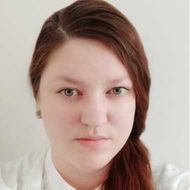Researchers at HSE Centre for Language and Brain Reveal Key Factors Determining Language Recovery in Patients After Brain Tumour Resection

Alina Minnigulova and Maria Khudyakova at the HSE Centre for Language and Brain have presented the latest research findings on the linguistic and neural mechanisms of language impairments and their progression in patients following neurosurgery. The scientists shared insights gained from over five years of research on the dynamics of language impairment and recovery.
The surgical removal of brain tumours located near language areas can result in various postoperative language disorders. Typically, language functions recover in the immediate postoperative period; however, two out of three patients may experience disorders in the chronic phase.
To understand the dynamics of language impairments and recovery after tumour resection, scientists at the HSE Centre for Language and Brain in Moscow and the Centre for Language and Brain Studies in Nizhny Novgorod have been assessing patients using the Russian Aphasia Test (RAT) at three key time points: before surgery, a few days post-surgery, and three to four months later.
By comparing comprehensive language test results with magnetic resonance imaging (MRI) data, it was possible to evaluate the importance of specific grey and white matter areas for language function.
The researchers examined how well key clinical factors—such as postoperative declines in language processing, tumour malignancy, resection volume and location, and the use of intraoperative language mapping—can predict long-term language recovery after surgery. Beyond predicting overall recovery, the researchers identified the brain regions involved in language processing that are most vulnerable to persistent deficits.
Maria Khudyakova, Director of the Centre for Language and Brain Studies at the HSE Campus in Nizhny Novgorod, studied the postoperative restoration of both comprehension and production of individual words: nouns and verbs.
'By testing the comprehension and production of nouns and verbs, we expected to observe a significant decline in performance on all tasks immediately after surgery, followed by a substantial improvement three to four months later. It was interesting to note that while the comprehension and production of nouns did not fully recover to preoperative levels, verbs—terms denoting actions—and the comprehension of all words were restored,' according to Khudyakova.
Maria Khudyakova added that although object naming had not fully recovered to its preoperative level, the naming rate for objects that were correctly identified had increased, meaning they were named more quickly.
Alina Minnigulova, Research Fellow at the HSE Centre for Language and Brain in Moscow, has participated in surgeries since 2017, initially testing patients in Nizhny Novgorod. In 2020, she joined a neurosurgical project in Moscow, which included a study on predictors of language recovery.
‘In 2024, we completed a five-year study on the impact of clinical and behavioural characteristics on language recovery in patients following the resection of glial tumours in the left hemisphere after a delay of three to six months,' explains Minnigulova. 'We found that smaller declines in language test scores and awake surgery involving brain mapping and speech monitoring both predict better language recovery in patients three to six months after surgery.'
Additionally, the scientists determined that verbal working memory and vocabulary retrieval, in particular verbs, are most vulnerable to persistent deficits.
'This study has been completed, but we continue to work with the neurosurgical population, investigating the neural correlations of language disorders, lateralisation, and the specification of language functions,' says Minnigulova.
See also:
Scientists Discover Why Parents May Favour One Child Over Another
An international team that included Prof. Marina Butovskaya from HSE University studied how willing parents are to care for a child depending on the child’s resemblance to them. The researchers found that similarity to the mother or father affects the level of care provided by parents and grandparents differently. Moreover, this relationship varies across Russia, Brazil, and the United States, reflecting deep cultural differences in family structures in these countries. The study's findings have been published in Social Evolution & History.
When a Virus Steps on a Mine: Ancient Mechanism of Infected Cell Self-Destruction Discovered
When a virus enters a cell, it disrupts the cell’s normal functions. It was previously believed that the cell's protective response to the virus triggered cellular self-destruction. However, a study involving bioinformatics researchers at HSE University has revealed a different mechanism: the cell does not react to the virus itself but to its own transcripts, which become abnormally long. The study has been published in Nature.
Researchers Identify Link between Bilingualism and Cognitive Efficiency
An international team of researchers, including scholars from HSE University, has discovered that knowledge of a foreign language can improve memory performance and increase automaticity when solving complex tasks. The higher a person’s language proficiency, the stronger the effect. The results have been published in the journal Brain and Cognition.
Artificial Intelligence Transforms Employment in Russian Companies
Russian enterprises rank among the world’s top ten leaders in AI adoption. In 2023, nearly one-third of domestic companies reported using artificial intelligence. According to a new study by Larisa Smirnykh, Professor at the HSE Faculty of Economic Sciences, the impact of digitalisation on employment is uneven: while the introduction of AI in small and large enterprises led to a reduction in the number of employees, in medium-sized companies, on the contrary, it contributed to job growth. The article has been published in Voprosy Ekonomiki.
Lost Signal: How Solar Activity Silenced Earth's Radiation
Researchers from HSE University and the Space Research Institute of the Russian Academy of Sciences analysed seven years of data from the ERG (Arase) satellite and, for the first time, provided a detailed description of a new type of radio emission from near-Earth space—the hectometric continuum, first discovered in 2017. The researchers found that this radiation appears a few hours after sunset and disappears one to three hours after sunrise. It was most frequently observed during the summer months and less often in spring and autumn. However, by mid-2022, when the Sun entered a phase of increased activity, the radiation had completely vanished—though the scientists believe the signal may reappear in the future. The study has been published in the Journal of Geophysical Research: Space Physics.
‘Engagement in the Scientific Process’: HSE Launches Master’s Programme in Neurobiology
The HSE University Academic Council has elected to launch a new Master's programme in Neurobiology for students majoring in Biology. Students of the programme will have access to unique equipment and research groups, providing them with the knowledge and experience to pursue careers in science, medicine and pharmacy, IT and neurotechnology, and education and HR services.
Banking Crises Drive Biodiversity Loss
Economists from HSE University, MGIMO University, and Bocconi University have found that financial crises have a significant negative impact on biodiversity and the environment. This relationship appears to be bi-directional: as global biodiversity declines, the likelihood of new crises increases. The study examines the status of populations encompassing thousands of species worldwide over the past 50 years. The article has been published in Economics Letters, an international journal.
Scientists Discover That the Brain Responds to Others’ Actions as if They Were Its Own
When we watch someone move their finger, our brain doesn’t remain passive. Research conducted by scientists from HSE University and Lausanne University Hospital shows that observing movement activates the motor cortex as if we were performing the action ourselves—while simultaneously ‘silencing’ unnecessary muscles. The findings were published in Scientific Reports.
Russian Scientists Investigate Age-Related Differences in Brain Damage Volume Following Childhood Stroke
A team of Russian scientists and clinicians, including Sofya Kulikova from HSE University in Perm, compared the extent and characteristics of brain damage in children who experienced a stroke either within the first four weeks of life or before the age of two. The researchers found that the younger the child, the more extensive the brain damage—particularly in the frontal and parietal lobes, which are responsible for movement, language, and thinking. The study, published in Neuroscience and Behavioral Physiology, provides insights into how age can influence the nature and extent of brain lesions and lays the groundwork for developing personalised rehabilitation programmes for children who experience a stroke early in life.
Scientists Test Asymmetry Between Matter and Antimatter
An international team, including scientists from HSE University, has collected and analysed data from dozens of experiments on charm mixing—the process in which an unstable charm meson oscillates between its particle and antiparticle states. These oscillations were observed only four times per thousand decays, fully consistent with the predictions of the Standard Model. This indicates that no signs of new physics have yet been detected in these processes, and if unknown particles do exist, they are likely too heavy to be observed with current equipment. The paper has been published in Physical Review D.




